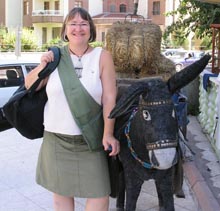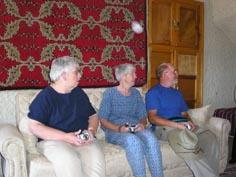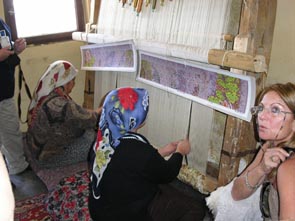|
9/13/05 Day Seven
 Left the
wonderful hotel at 9:00 am. Went via bus to Goreme valley to a monastery.
There were 350 churches with frescoes from the mid-11th c. St
Paul was born into a Jewish family with a well off father. He was a Roman
citizen who accepted Christianity in his teens. He changed his name from
Saul to Paul and went to Antioch where St. Peter was. 47 AD built up
followers and created the name of a group. He traveled to Anatolia and
Cyprus and went to a passage through the Toro Mountains. He went to Kayseri
where the Romans were dominant who persecuted Christians who hid in the
Cappadoccia mountains. Paul went to Konya. In 323 AD, Constantine accepted
Christianity as a state religion. Left the
wonderful hotel at 9:00 am. Went via bus to Goreme valley to a monastery.
There were 350 churches with frescoes from the mid-11th c. St
Paul was born into a Jewish family with a well off father. He was a Roman
citizen who accepted Christianity in his teens. He changed his name from
Saul to Paul and went to Antioch where St. Peter was. 47 AD built up
followers and created the name of a group. He traveled to Anatolia and
Cyprus and went to a passage through the Toro Mountains. He went to Kayseri
where the Romans were dominant who persecuted Christians who hid in the
Cappadoccia mountains. Paul went to Konya. In 323 AD, Constantine accepted
Christianity as a state religion.

St Basil,
St. Gregory and one other saint went to the Black Sea in eastern Turkey
where there is a rain forest. They built a church, which became a monastery.
They sent letters to get teachers to teach Christian dogma. Monastic life =
every monk had a classroom; used illustrations made by artists financed by
rich people. Until about 1924, monastery functioned community fed monks who
were not confined to it; went to Greece during shift by the British. Frescos
showed Jesus naked but later added a loin cloth. Dread were wrapped in a
shroud (both Christian and Muslim). Muslims carried 7 meters of cloth as a
turban to be used for burial.
 Sultans
wore flowers in their hair. Black scarved women are not necessarily
fundamental but folkloric outfits. Sultans
wore flowers in their hair. Black scarved women are not necessarily
fundamental but folkloric outfits.
There
were no Roman theatre or Hellenistic structures in Cappadoccia so they
painted designs. Rooster represents St. Peter; not know who was the
cockroach; Jesus with red cheeks and red hair; baptismal fonts.
Helena,
mother of Constantine, was very religious and convinced her son to become a
Christian as well. Jesus’ cross was brought to Istanbul and brought to a
Greek monastery. Catholics took half to Rome. Saw an image of a
hermaphrodite, a woman with a beard.
Jesus on
a cross looks healthy standing between a moon and a sun. Animals were
warming Christ with their breath. There is also an image of the sultan of
Selchukians shaking hands with a saint. Avanos is
a pottery city. We crossed the Red River which produces the clay. You can
see piles of broken pottery (seconds) in the middle of city streets. We
visited a workshop of artist Galip who represented Turkey. He is a 5th
generation pottery. He uses his feet to drive a subterranean wheel. He made
a bowl, tea pot and showed us how to make a hollow tube. Items are fired 10
hours after drying in the sun. Avanos is
a pottery city. We crossed the Red River which produces the clay. You can
see piles of broken pottery (seconds) in the middle of city streets. We
visited a workshop of artist Galip who represented Turkey. He is a 5th
generation pottery. He uses his feet to drive a subterranean wheel. He made
a bowl, tea pot and showed us how to make a hollow tube. Items are fired 10
hours after drying in the sun.
Wood, hay
and dried grape seeds are used for firing. Not use hay if glazed objects are
being fired. First firing is at 950 degrees, not wrap objects
Between
firings, dip in molten glass as a coating/glaze after all painting on plate, Second
firing, lean against pot and pack hay for changing color
Started
using electric kilns because wood is expensive
Blue =
ward off evil
Tulips =
Turkish
Border=
Cappadocia valleys Offers a
summer workshop for foreigners, Clay from
river beds and mountains. Sizzles when it meets water. Dries quickly.
Tile
making began in Iznik. Use quartz as a base (from powder); translucent; very
expensive; Galip makes replicas of plates residing in European museums.
Lunch at
Dayin Yeri restaurant – southern Turkish meat, bread, cut up salad in
pomegranate juice. Meli brought out lemon water which she poured over our
hands at the end of the meal. The nice driver of the bus passed out baklava
which Meli had purchased.
Caravanseri at Sultanhan Many
caravanseri as part of the Silk Route 1228 AD
4,000
trade; Seljukians superimposed on the old route; offered a safe and
comfortable play to stay. A camel can travel 40-50 km per day. Some people
stayed the whole winter at a caravanseri. The trip was 18 months from Xian
in China to the Aegean Sea. One had a spiral staircase to the second floor.
Males were in one area. Women were the owners of a caravan (including the
wife of Muhammad who was her accountant). Accountants had the most important
room. A mosque was in the center. The majority of travelers were Muslims.
Exchange of cultures. Stables accommodated animals and stuff they carried.
The structure of the caravanseri was later copied for European cathedrals.
There are
no fences. Farmers put 8 stones on the top of each other at the corner of
their property to indicate if it is for grazing by others or not. There are
no granaries but huge mounds covered with hay.
Islam
Religion
is what makes people happy. Rules incorporate social behavior, economics,
psychological aspects of person. 1,400 years ago, rules which were not
appropriate today. There are 5 pillars of Islam
visit to Mecca – Haj
giving alms
fasting during Ramadan
praying 5 times per day
only one god and Mohammed is a prophet (the last one)
baptism
no clergy you submit to god
Praying 5
times a day
ablution exercise and stretching 1.5 hrs per day like meditation
Fasting
for a month
begins at puberty changes 10 days/year wake up before sunrise drink water;
none before break fast at sunset with at least one other person
Giving
alms
face-to-face 1/40 of your wealth yearly; not in money but in
goods
Go to
Mecca once
wrap yourself in a shroud
sacrifice animal to give to the next campers; same with water
Konya
Hotel
Baykara; average room and bath Dinner at
Kosk – okra soup; special Konya stuffed grape leaves, yogurt and garlic,
sauted bread in olive oil, onions, sumak and meat balls, big round bread. Afterwards we
went to the back of an antiques store and sat on a pile of kilims to listen
to 3 young Turkish musicians. Jack Larson, a NYC-based designer, joined us.
|
![]()
